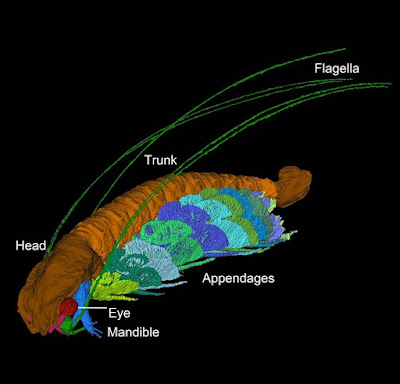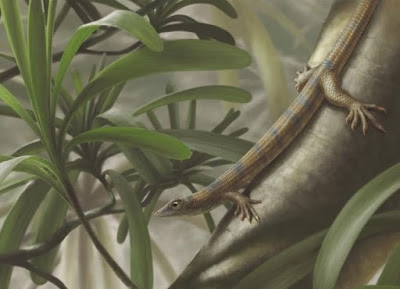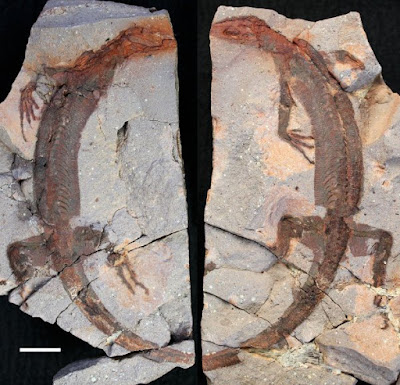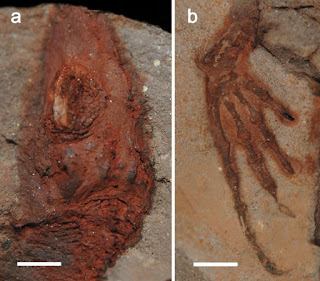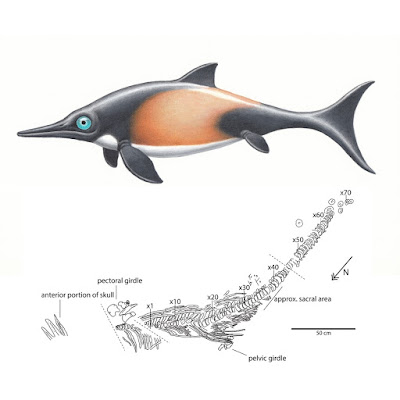 |
| Keilhauia nui Delsett, Roberts, Druckenmiller & Hurum, 2017 reconstruction: Esther van Hulsen |
Abstract
In spite of a fossil record spanning over 150 million years, pelvic girdle evolution in Ichthyopterygia is poorly known. Here, we examine pelvic girdle size relationships using quantitative methods and new ophthalmosaurid material from the Slottsmøya Member Lagerstätte of Svalbard, Norway. One of these new specimens, which preserves the most complete ichthyosaur pelvic girdle from the Cretaceous, is described herein as a new taxon, Keilhauia nui gen. et sp. nov. It represents the most complete Berriasian ichthyosaur known and the youngest yet described from the Slottsmøya Member. It is diagnosed on the basis of two autapomorphies from the pelvic girdle, including an ilium that is anteroposteriorly expanded at its dorsal end and an ischiopubis that is shorter or subequal in length to the femur, as well as a unique character combination. The Slottsmøya Member Lagerstätte ichthyosaurs are significant in that they represent a diverse assemblage of ophthalmosaurids that existed immediately preceding and across the Jurassic–Cretaceous boundary. They also exhibit considerable variation in pelvic girdle morphology, and expand the known range in size variation of pelvic girdle elements in the clade.
Systematic Paleontology
Ichthyosauria de Blainville 1835
Neoichthyosauria Sander 2000
Thunnosauria Motani 1999
Ophthalmosauridae Baur 1887
Keilhauia gen. nov.
Keilhauia nui sp. nov.
Holotype and only specimen: PMO 222.655, an articulated, partial skeleton consisting of an incomplete rostrum, the dorsal and preflexural vertebrae, the right pectoral girdle and forefin, most of the pelvic girdle and both femora.
Etymology: Genus name in honor of Baltazar Mathias Keilhau (1797–1858), the first Norwegian geologist to do fieldwork in the Arctic. He was part of an expedition to Svalbard (Spitsbergen) in 1827. His collection is housed at the Natural History Museum in Oslo, Norway, where PMO 222.655 is also housed. Species name in honor of Natur og Ungdom (Young Friends of the Earth Norway) working to protect the Arctic environment, who celebrate their 50 year anniversary in 2017.
Holotype locality: Island of Spitsbergen, north side of Janusfjellet, approximately 13 km north of Longyearbyen, Svalbard, Norway. UTM WGS84 33X 0518847 8696044
Holotype horizon and stage: Slottsmøya Member, Agardhfjellet Formation, Janusfjellet Subgroup, early Berriasian, Early Cretaceous. 44.8 metres above the echinoderm marker bed.
 |
| [lower] Fig 3. Skeletal map of Keilhauia nui (PMO 222.655) viewed from the side stratigraphically down, i.e. the prepared side. Vertebrae numbers (“x#”) indicate position relative to the anterior end of the preserved skeleton and do not correspond to their actual position in the column. Dashed lines show three faults. Scale bar equals 50 cm. Modified from Delsett et al. 2016. |
Lene Liebe Delsett, Aubrey J. Roberts, Patrick S. Druckenmiller and Jørn H. Hurum. 2017. A New Ophthalmosaurid (Ichthyosauria) from Svalbard, Norway, and Evolution of the Ichthyopterygian Pelvic Girdle. PLoS ONE. 12 (1): e0169971. DOI: 10.1371/journal.pone.0169971
Nyoppdaget fiskeøgle oppkalt etter Natur og Ungdom @ NaturogUngdom
---------------------------------------------------------------
روابط التحميل والمشاهدة، الروابط المباشرة للتحميل
او
شاهد هذا الفيديو القصير لطريقة التحميل البسيطة
كيف تحصل على مدونة جاهزة بآلاف المواضيع والمشاركات من هنا
شاهد قناة منتدى مدونات بلوجر جاهزة بألاف المواضيع والمشاركات على اليوتيوب لمزيد من الشرح من هنا
رابط مدونة منتدى مدونات بلوجر جاهزة بآلاف المواضيع والمشاركات في أي وقت حــــتى لو تم حذفها من هنا
شاهد صفحة منتدى مدونات بلوجر جاهزة بألاف المواضيع والمشاركات على الفيس بوك لمزيد من الشرح من هنا
شاهد صفحة منتدى مدونات بلوجر جاهزة بألاف المواضيع والمشاركات على الفيس بوك لمزيد من الشرح من هنا
تعرف على ترتيب مواضيع منتدى مدونات بلوجر جاهزة بآلاف المواضيع والمشاركات (حتى لا تختلط عليك الامور) من هنا
ملاحظة هامة: كل عمليات تنزيل، رفع، وتعديل المواضيع الجاهزة تتم بطريقة آلية، ونعتذر عن اي موضوع مخالف او مخل بالحياء مرفوع بالمدونات الجاهزة بآلاف المواضيع والمشاركات، ولكم ان تقوموا بحذف هذه المواضيع والمشاركات والطريقة بسيطة وسهلة. ــــــــــــــــــــــــــــــــــــــــــــــــــــــــــــــــــــــــــــــسلامـ.





